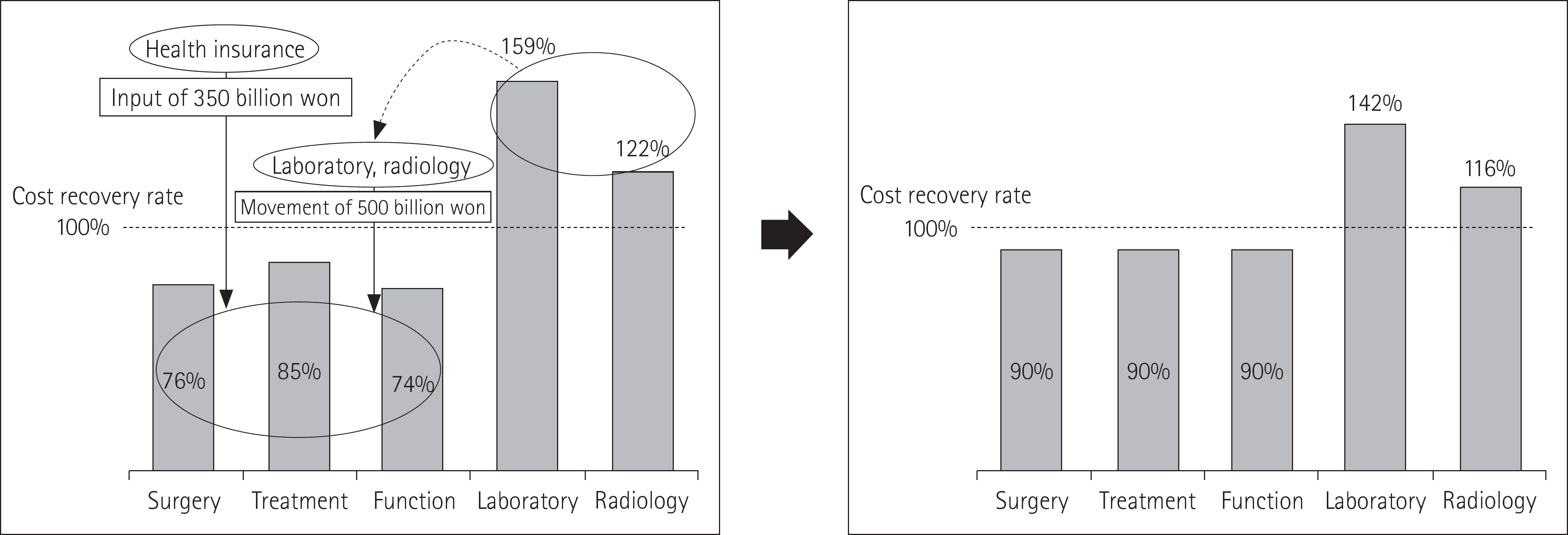Abstract
From 2010 to 2015, the Ministry of Health and Welfare conducted the second edition of research on the relative value scale to correct the imbalance in the current relative value scale among medical departments by converting the current system, which yields calculations according to each of the 40 medical departments, to a new calculation system based on five procedures (surgery, treatment, function tests, laboratory examinations, and radiologic examinations). As a result of this research, a total of 850 billion won was reallocated to the procedures that have low cost recov-ery rates, such as surgery, treatment, and function tests, in order to correct the im-balance. This figure included a sum of 350 billion won from health insurance finan-cial inputs and 500 billion won which consisted of 363.7 billion won earned through cost reduction of laboratory examinations and 136.3 billion won from radiologic ex-aminations which have a relatively high cost recovery rate. For the growth of radi-ology, it is very important to obtain an appropriate relative value unit for radiologic tests. If the cost of radiologic tests were to be reduced simply because of their high cost recovery rate, there will be serious consequences to the future of radiology. Be-cause the government takes only the cost recovery rate into account while estab-lishing the cost policy, it should be seriously considered not to pursue quantitative growth by increasing the number of radiologic tests. Instead, we should mainly fo-cus on qualitative issues such as reducing the number of double-checking redun-dant and unnecessary tests, and on creating a policy of differential cost by qualitative management of radiologic equipment.
REFERENCES
1.Hahm MI. Trends and recommendations in the resource-based relative value system. J. Korean Soc Vasc Surg. 2004. 20:276–281.
2.Kim HJ., Sohn MS., Park EC., Yeom YK., Kim JH., Lee KT, et al. Resource-based relative value scale for revision of health insurance cost. Yonsei University Institute of Health Servic-es Research;1997.
3.Korean Medical Association. Korean standard classification of procedures in medicine. Reston: Korean Medical Asso-ciation;1997.
4.Korean Dental Association. Korean standard classification of procedures in dentistry. Reston: Korean Dental Association;1997.
5.Park WS. Payment system of resource-based Relative Value Scale. J Korean Med Assoc. 2001. 44:921–926.
6.Park EC. Payment system of resource-based relative value scale. Korean J Nephrol. 2003. 22:426–437.
7.Kim YJ. An organization of professionals should revise the resource-based relative value system. Healthc Policy Forum. 2014. 12:16–24.
8.Kang GW., Lee CS. The refinement project of health insurance relative value scales: results and limits. Health Policy Manag. 2007. 17:1–25.
Fig. 1.
In the first revision of the relative value scale, the calculation system of relative value scales is based on 40 medical departments and the total score of the relative value scale is fixed for each department. The second revision is conducted to correct the imbalance in current relative value scales among medical departments by converting the calculation system from being based on each of the 40 medical departments to a new calculation system based on five procedures (surgery, treatment, function tests, laboratory examinations, and radiologic examinations). FNC = function, IM = internal medicine, LAB = laboratory, OPH = ophthalmology, RAD = radiology, SURG = surgery, TX = treatment

Fig. 2.
The changes in the cost recovery rate according to the second revision of the relative value scale. A total of 850 billion won, which is a sum of 500 billion won (363.7 billion won earned through cost reduction of laboratory examinations plus 136.3 billion won from radiologic ex-aminations) and 350 billion won from health insurance financial inputs, is reallocated to the procedures that have low cost recovery rates in or-der to increase their cost recovery rate to 90%.





 PDF
PDF ePub
ePub Citation
Citation Print
Print


 XML Download
XML Download